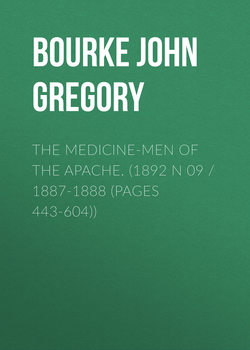Читать книгу The Medicine-Men of the Apache. (1892 N 09 / 1887-1888 (pages 443-604)) - Bourke John Gregory - Страница 4
CHAPTER I
THE MEDICINE-MEN, THEIR MODES OF TREATING DISEASE, THEIR SUPERSTITIONS, PARAPHERNALIA, ETC
HAIR AND WIGS
ОглавлениеThe medicine-men of the Apache were, at least while young, extremely careful of their hair, and I have often seen those who were very properly proud of their long and glossy chevelure. Particularly do I recall to mind the "doctor" at San Carlos in 1885, who would never allow his flowing black tresses to be touched. But they do not roach their hair, as I have seen the Pawnee do; they do not add false hair to their own, as I have seen among the Crow of Montana and the Mohave of the Rio Colorado; they do not apply plasters of mud as do their neighbors the Yuma, Cocopa, Mohave and Pima, and in such a manner as to convince spectators that the intent was ceremonial; and they do not use wigs in their dances. Wigs made of black wool may still be found occasionally among the Pueblos, but the Apache do not use them, and there is no reference to such a thing in their myths.
It is to be understood that these paragraphs are not treating upon the superstitions concerning the human hair, as such, but simply of the employment of wigs, which would seem in former days among some of the tribes of the Southwest to have been made of human hair presented by patients who had recovered from sickness or by mourners whose relatives had died.106 Wigs with masks attached were worn by the Costa Ricans, according to Gabb.107
Some of the Apache-Yuma men wear long rolls of matted hair behind, which are the thickness of a finger, and two feet or more in length, and composed of old hair mixed with that growing on the head, or are in the form of a wig, made of hair that has been cut off when mourning the dead, to be worn on occasions of ceremony.108
Observations of the same kind have been made by Speke upon the customs of the people of Africa in his Nile,109 concerning the Kidi people at the head of the Nile; by Cook, in Hawkesworth's Voyages,110 speaking of Tahiti, and by Barcia,111 speaking of Greenland. Sir Samuel Baker describes the peculiar wigs worn by the tribes on Lake Albert Nyanza, formed of the owner's hair and contributions from all sources plastered with clay into a stiff mass.112
Melchior Diaz reported that the people of Cibola "élèvent dans leurs maisons des animaux velus, grands comme des chiens d'Espagne. Ils les tondent, ils en font des perruques de couleurs." This report was sent by the Viceroy Mendoza to the Emperor Charles V. Exactly what these domesticated animals were, it would be hard to say; they may possibly have been Rocky Mountain sheep,113 though Mr. Cushing, who has studied the question somewhat extensively, is of the opinion that they may have been a variety of the llama.
The Assinaboine used to wear false hair, and also had the custom of dividing their hair into "joints" of an inch or more, marked by a sort of paste of red earth and glue;114 The Mandan did the same.115 In this they both resemble the Mohave of the Rio Colorado. "The Algonquins believed also in a malignant Maniton. * * * She wore a robe made of the hair of her victims, for she was the cause of death."116
The Apache, until within the last twenty years, plucked out the eyelashes and often the eyebrows, but only a few of them still persist in the practice. Kane says that the Winnebagoes "have the custom of pulling out their eyebrows."117 Herrera says that among the signs by which the Tlascaltecs recognized their gods when they saw them in visions, were "vianle sin cejas, i sin pestañas."118
106
The reader interested in this matter may find something bearing upon it in Diego Duran, lib. 1, cap. 36, p. 387; Torquemada, Mon. Indiana, lib. 9, cap. 3; Venegas, History of California, vol. 1, p. 105; Gomara, Conq. de Mexico, p. 443; Herrera, dec. 4, lib. 8, p. 158; Maximilian of Wied, p. 431, and others; The "pelucas" mentioned of the Orinoco tribes by Padre Gumilla would seem to be nothing more than feather head-dresses; p. 66.
107
Tribes and Languages of Costa Rica, Proc. Am. Philos. Soc., Philadelphia, 1875, p. 503.
108
Corbusier, in American Antiquarian, Sept., 1886, p. 279.
109
Source of the Nile, p. 567.
110
Vol. 2, p. 193.
111
Ensayo Cronologico, p. 139.
112
For the Shamans of Kodiak, see Lisiansky, Voyage, London, 1814, p. 208; for the Mexicans, Padre José Acosta, Paris, 1600, cap. 26, p. 256; Society Islands, Malte-Brun, Univ. Geography, vol. 3, lib. 58, p. 634, Boston, 1825. Sir Samuel Baker, The Albert N'yanza, vol. 1, p. 211.
113
Ternaux-Compans, vol. 9, p. 294.
114
Catlin, North American Indians, London. 1845, vol. 1, p. 55.
115
Ibid., p. 95.
116
Parkman, Jesuits in North America, p. lxxxiv.
117
Wanderings of an Artist in North America, p. 40.
118
Dec. 2, lib. 6, p. 161.
